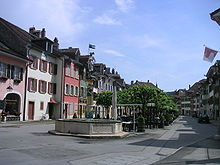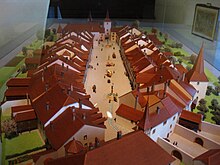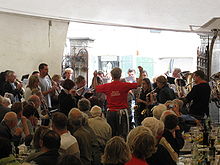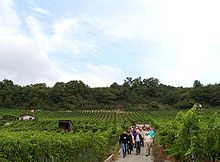Le Landeron
| Le Landeron | |
|---|---|
| State : |
|
| Canton : |
|
| District : | No district division |
| BFS no. : | 6455 |
| Postal code : | 2525 |
| UN / LOCODE : | CH LDO |
| Coordinates : | 571.74 thousand / 211682 |
| Height : | 434 m above sea level M. |
| Height range : | 429-1056 m above sea level M. |
| Area : | 10.28 km² |
| Residents: | 4645 (December 31, 2018) |
| Population density : | 452 inhabitants per km² |
| Website: | www.landeron.ch |
|
Le Landeron seen from the Jura |
|
| Location of the municipality | |
Le Landeron ( French [lə lɑ̃dʀɔ̃] , in the former Franco-Provencal local dialect [y lɛ̃ˈdrɔ̃] , formerly German Landern ) is a political municipality in the Swiss canton of Neuchâtel . Between 1875 (merger with Combes ) and 1966 the municipality was officially called Landeron-Combes .
geography
The historic town of Le Landeron is located at the southern foot of the Jura , on the banks of the Zihl Canal and Lake Biel . The old town was built in the once marshy Zealand between the arms of the then multi-armed meandering Zihl on a sandy island, a round, sandy bottom [sur des Landes rondes], as Hans Jacob Leu wrote in the oldest federal encyclopedia in part in terms of folk etymology . The name actually goes back to the Gallo-Roman * landa "flat wasteland" (cf. French lande ), supplemented by the suffix -erône . While the city lies on the Zihl plain, the new quarters with the Biel - Neuchâtel line stretch northwards.
The area of the municipality is 1031 hectares; 44% of this is covered with forest, 41% is used for agriculture and 13% is built over.
history
A heavily weathered cup stone with around 90 bowls was found near Les Prises . There are individual finds from the pile dwelling period . Roman coins were found between Landern and Neuenstadt. The fossils found in the valley of Nugerol are in the museums of Biel and Basel.
As early as the early Middle Ages, a fortress called Nugerol stood on the hill at the foot of the Jura . It was built by the Counts of Neuchâtel against the Diocese of Basel . 1260 Nugerol was with the carte blanche equipped, making it the market town. In the same year, however, the town was razed to the ground in an armed conflict between the Count and the Prince-Bishop of Basel. As a result, the prince-bishop built Schlossberg Castle in 1283 and the market town of Neuenstadt in 1312 .
In 1325, the Abbey of St. Johannsen (St. Jean) sold the Landeren grazing grounds to the Count of Neuchâtel to build a new fortified village. The moraine was drained by ditches . The place was chosen so that it came to lie on the bank of the Zihl and was on the main traffic arteries of that time. In 1349 Le Landeron was raised to a barony in recognition of his services and granted city rights.
In 1449 the now wealthy citizens of Le Landeron made an "eternal alliance" with the city of Solothurn ; the latter had long before cast an eye on the areas of the Seeland , over which the diocese of Basel , the Counts of Neuchâtel and the Bernese were fighting. This mutual " castle law " was confirmed several times until 1783. This power struggle reached a climax in the 16th century when the Neuchâtel ( Farel ) wanted to reform Le Landeron . Thanks to Solothurn's support, the town and neighboring Cressier remained Catholic. In 1707 the Solothurners finally had to withdraw from the area when the Prussians took over Neuchâtel (see also the history section in the article Canton Neuchâtel ).
While the Catholic cantons, as part of the Gregorian calendar reform in 1584, switched to the Gregorian calendar , and thus immediately changed from January 12th to January 22nd, the Protestant cantons refused to accept the "papist" calendar until the 18th century. In Le Landeron and Cressier, this meant that the two communities lived ten days before the rest of the Neuchâtel for over a hundred years, with their own Sunday, their own Christmas ...
Le Landeron built his wealth on agriculture and handicrafts . Thanks to various licensees, the city was independent and the citizens were self-confident. The three guilds , some of which still exist today, have contributed to this.
In the 19th century, Le Landeron moved with the times and relied on freedom of trade and the values of the French Revolution . After the creation of the Republic and Canton of Neuchâtel in 1848, it joined this and built road and rail connections and factories for the growing watch industry .
When the Grosse Moos was drained during the first Jura water correction , agriculture experienced a boom (vegetable crops). In 1888 the little village of Combes was incorporated.
Arts and Culture

From the cultural area, the two feasts of Saints Sebastian , Fabian and Antonius , celebrated in January by the two guilds , as well as Corpus Christi , which to this day are jointly organized by the parish, the civil parish, associations and the guilds with great sympathy of the long-established residents, are worth mentioning Population is committed.
Old town
With the exception of the demolished house next to the portette, the old town has been preserved and is under the protection of the Swiss Confederation.
The old town hall dates from the 15th century. It consists of two parts: the Chapel of the Ten Thousand Knights and a secular house. On the first floor there is a Gothic hall with a vaulted ceiling, six uneven windows and paneling from 1647. The town hall is home to the town museum.
The only church within the city walls is the Chapel of the Ten Thousand Knights , built in 1450 on the ground floor of the town hall. From 1699 to the end of the 20th century it was served by the Capuchins of the little monastery founded in 1696. Contrary to the previous rule, the women in this Catholic church sit on the right (instead of the left) to thank them for driving the reformer Farel away while the men were at work in the vineyards. The two guild fairs take place here annually in January . The parish church of St. Mauritius , which is located outside the city and bulwark, was built in 1832 as a replacement for an earlier dilapidated church in Nugerol.
The castle is right next to the city gate . The modern wall paintings in the courtyard point to the two guilds St-Fabien and St-Antoine , the civil parish (Coopération de St-Maurice; name of the parish church) and the centuries-old military and economic partnership with the city of Solothurn downstream.
The Hôtel de Nemours is a medieval tavern that is still run by a long-established family today. This building of historical interest takes its name from the Duchesse (Duchess) de Nemours.
The main street is the center of the town of Le Landeron. Here you can find the fountain of the Brave (fontaine du Brave) , built around 1549, and the fountain of the city patron Mauritius from 1574. The two fountains are connected by an avenue of lime trees, which was planted under the rule of Marshal Louis-Alexandre Berthier . Most of the houses in the old town date from the 16th and 17th centuries, with the core dating from the 14th century. The unusual width of the alley results from the fact that it was originally the building site for two more rows of houses, separated by a moat . But after one half of the city had burned down without the fire reaching the other side, these plans were abandoned and the room was used as a marketplace.
Museums
The history of the city is presented in the city museum in the historic town hall (Musée de l'Hôtel de Ville) . There are old weapons such as cannons from the battle of Murten , flags, armor, objects from the old abbey, but also etchings and Neuchâtel clocks . Many old viticulture tools are also on display.
The Center scolaire des Deux Thielles (C2T) has a permanent exhibition of drawings by Swiss and international artists. The collection was created by the Swiss artist Martin Disler .
Le Landeron is known as the «city of antiques ». Antique shops, second hand shops , craft shops and art galleries are lined up in the old town . On the last weekend in September, the largest flea market and antiques market in Switzerland takes place here.
population
Population development
| year | 1750 | 1850 | 1900 | 1950 | 2000 | 2010 |
|---|---|---|---|---|---|---|
| Residents | 591 | 1 012 | 1 423 | 1 724 | 4 227 | 4,441 |
Source: Historical Lexicon of Switzerland
languages
The official and lingua franca is French. Le Landeron is located directly on the language border, which is formed by the Zihl.
Denominations
Traditionally, Le Landeron is Roman Catholic (see history ). Due to the strong growth of the community as part of the Neuchâtel and Bern agglomeration, the situation changed in the second half of the 20th century, particularly due to the large number of newcomers.
| year | 1904 | 1980 | 1990 | 2000 |
|---|---|---|---|---|
| Protestants | 49% | 50% | 45% | 39% |
| Catholics | 51% | 41% | 39% | 35% |
| Other | 2% | 3% | 5% | |
| No | 7% | 13% | 21% |
origin
| year | 1784 | 1900 | 1904 | 1950 | 1980 | 1990 | 2000 |
|---|---|---|---|---|---|---|---|
| population | 685 | 1423 | 1446 | 1724 | 3287 | 3899 | 4227 |
| Swiss | 1344 | 1662 | 2853 | 3316 | 3560 * | ||
| in % | 94 | 96 | 87 | 85 | 84 | ||
| Foreigners | 79 | 62 | 434 | 583 | 667 | ||
| in % | 6th | 4th | 13 | 15th | 16 |
* including 286 naturalized and 466 dual citizens
age structure
| year | 1980 | 1990 | 2000 | |||
|---|---|---|---|---|---|---|
| 0-19 | 935 | 28% | 978 | 25% | 1048 | 25% |
| 20-39 | 1094 | 33% | 1249 | 32% | 1166 | 28% |
| 40-64 | 850 | 26% | 1199 | 31% | 1442 | 34% |
| 65- | 408 | 12% | 473 | 12% | 571 | 14% |
| total | 3287 | 3899 | 4227 | |||
Percentages rounded, therefore not always exactly 100% in total.
politics
legislative branch
The legislature consists of the General Council (conseil général) with 41 members. The elections in recent years have led to the following results
| year | 2000 | 2004 | 2008 |
|---|---|---|---|
| radical | 7th | 7th | 6th |
| Liberal PPN | 10 | 9 | 7th |
| Socialists | 10 | 14th | 10 |
| Canette (beer can party) | 14th | 11 | 13 |
| UDC | 5 |
National elections
The voting shares of the parties in the 2015 National Council election were: FDP 33.8%, SVP 23.7%, SP 20.8%, GPS 5.3%, CVP 4.5%, PdA 4.4%, glp 3.5 %, BDP 1.4%, list du vote blanc 1.4%.
Town twinning
Le Landeron has had an - originally military - partnership with the city of Solothurn since 1449 .
economy
Le Landeron is a traditional wine-growing town. The vineyards are located on the slopes facing Lake Biel and the little village of Combes. The most famous vineyards have been run for centuries by the Frochaux, Ruedin families and the Solothurn Citizens Hospital (vigne de l'Hôptal de Soleure) . Originally, fishing was also an important source of income, today vegetable growing.
Tourism is very important for the small town.
leisure
In addition to the sights described under “Art and Culture”, Le Landeron has a harbor, a lido, a campsite and a wide range of leisure activities. The swimming pool is located directly on the lake and has pools and beaches. The 67 m long water slide is a special attraction . In the boat harbor, water sports are particularly popular . Rowing boats, sailing boats, fishing boats and pedalos can be viewed and some can also be rented. In the lake you can sail, dive, surf, fish and swim.
In addition to water sports, the immediate vicinity of Le Landeron offers numerous leisure opportunities. The nearby Zihl Canal and the Alten Zihl nature reserve are ideal for walks, hikes and bike rides. Recreational anglers can acquire time-limited fishing permits and pursue their hobby here. Furthermore, Le Landeron has a developed skate slope.
traffic
Le Landeron is well connected to the Swiss transport network. It can be reached by car via the A5 , by train with the regional lines of the SBB from Neuchâtel or Biel . It is also served by the shipping lines on Lake Biel and a Postbus line to Gals and Erlach . However, regional public transport is only poorly developed and plays a very minor role (it fell from around 20% to around 10% between 1980 and 2000).
coat of arms
Upper half: divided into three parts in gold and in the middle three silver rafters on a red background: from the pre-republican state coat of arms of the canton of Neuchâtel ;
lower half: two silver fish on a blue background: reference to a formerly important industry.
Personalities
- René Quellet (1931–2017), pantomime artist
literature
- Germain Hausmann: Landeron, Le (parish). In: Historical Lexicon of Switzerland .
- Olivier Girardbille: Combes. In: Historical Lexicon of Switzerland .
- Germain Hausmann: Le Landeron, Le (Kastlanei). In: Historical Lexicon of Switzerland .
- Armorial du Landeron . Imprimerie Zwahlen SA, St. Blaise 1991. The long-established families and their coats of arms. French.
- Le Landeron. Histoires d'une ville . Gilles Attinger, Hauterive. History of the city. French.
- Le Landeron . Agence Schneider, Le Landeron 1998. Brief description of the story with many old pictures. German and French.
- Jean Courvoisier: Le Landeron. (Swiss Art Guide, No. 383). Edited by the Society for Swiss Art History GSK. Bern 1986.
Web links
Individual evidence
- ↑ Permanent and non-permanent resident population by year, canton, district, municipality, population type and gender (permanent resident population). In: bfs. admin.ch . Federal Statistical Office (FSO), August 31, 2019, accessed on December 22, 2019 .
- ↑ a b Lexicon of Swiss municipality names . Edited by the Center de Dialectologie at the University of Neuchâtel under the direction of Andres Kristol. Frauenfeld / Lausanne 2005, p. 517.
- ↑ Bartolini Lionel: Une résistance à la réforme dans le pays de Neuchâtel: Le Landeron et sa région (1530–1562). Alphil, Neuchâtel 2006 ISBN 2-940235-18-X .
- ↑ Museum site of the Canton of Neuchâtel ( Memento of the original from May 3, 2015 in the Internet Archive ) Info: The archive link was inserted automatically and has not yet been checked. Please check the original and archive link according to the instructions and then remove this notice. , accessed March 25, 2015.
- ^ Germain Hausmann: Le Landeron (community). In: Historical Lexicon of Switzerland . March 10, 2009 , accessed June 5, 2019 .
- ↑ Résultats des élections municipality Le Landeron ( page no longer available , search in web archives ) Info: The link was automatically marked as defective. Please check the link according to the instructions and then remove this notice. (PDF; 111 kB)
- ^ Election du Conseil National du October 18, 2015, Résultats des partis - Les suffrages. (aspx) Chancellerie d'État neuchâtelois, October 18, 2015, archived from the original on November 1, 2015 ; Retrieved October 30, 2016 (French).














